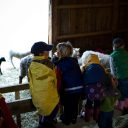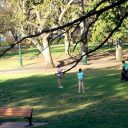


Protecting our thirsty urban trees from more harsh summers
Urban forests are great for keeping our cities cool, but as temperatures go up they need water to survive – and that’s where redirecting storm water to street trees comes in. With increasing heat in the...Read more
Teaching children about sustainability makes a city cleaner for everyone
Sustainability and the green movement often find themselves associated with the political left, yet there are many practical and economic reasons for sustainable living. Without trying to push one political agenda or another — teaching...Read more
Age diversity for social cohesion
Creating public space that encourages social integration has never been more important. Here, Samuel Williams of planning specialists Arup, explains why child-friendly cities must adopt inter-generational design principles. ‘Designing cities for all’ is easy to say but if...Read more
Resilience: connecting young people with nature
A resilient city is one where young people have easy access to nature and outdoor play, argues Samuel Williams of the planning and design company, Arup. Here, her explains why it is time for designers to...Read more
Osteria Ai Pioppi. If you want to play, you have to push and sweat
Bruno Ferrin is the inventor and creator of an ecological park in Nervesa della Battaglia, in the province of Treviso, in Italy. The particularity of this park, for children and adults both, is that there...Read more
Teens who grow up surrounded by nature are less likely to be aggressive
Whether it’s an urban park or a forested wilderness, being close to nature can benefit young people in unexpected ways. The power of nature has been studied on many occasions. It has been found to calm...Read more
Kolle 37, keeps the adventure playground tradition alive in East Berlin
The highly influential Danish landscape architect, C. T. Sørensen, took inspiration for the realization of a new specific type of informal play space from his observations of children playing on a construction site after hours....Read more
Play Through the Eyes of a Child
Unique to the playing child, or children, at any one moment in time is the motivation to create something out of apparently nothing. Constantly exposed to so much stimuli. But with, often, limited opportunities to...Read more
Biophilic cities: don’t forget the buildings!
Many recent movements have promoted the greening of cities and connecting children and families to nature. A growing body of research tells us that nature provides many benefits, including increased health and well-being. In participatory...Read more
Green goes to school – the participatory approach
In the last thirty years, a lot of schoolyards in Berlin have changed their aspect, becoming places where children can spend their free time in a beneficial way, developing their confidence and self-esteem without the...Read more
Mobile preschools: bringing nature to children in cities
The conceptualisation of mobile preschools varies. In some rural areas, such as Colorado, USA and Australia’s Northern Territory, busses are redesigned to serve as classrooms that move between several communities with a of lack preschools, in...Read more
How city leaders can help children to engage with nature
The continued efforts of NLC’s Cities Connecting Children to Nature initiative and the Children & Nature Network are geared towards providing children the most optimal opportunities to play, grow, and learn in the great outdoors. The...Read more
Natural space trains children’s mind
In northern European cities, there is a large number of wild and adventure playgrounds, where children can learn from nature and from their personal experiences. There are playgrounds planned in a way to stimulate an...Read more
Children seek greater access to nature
Although city children want more contact with nature, they do not always feel they have enough access to – or freedom within – the natural spaces that are already there. In a recent analysis of...Read more

